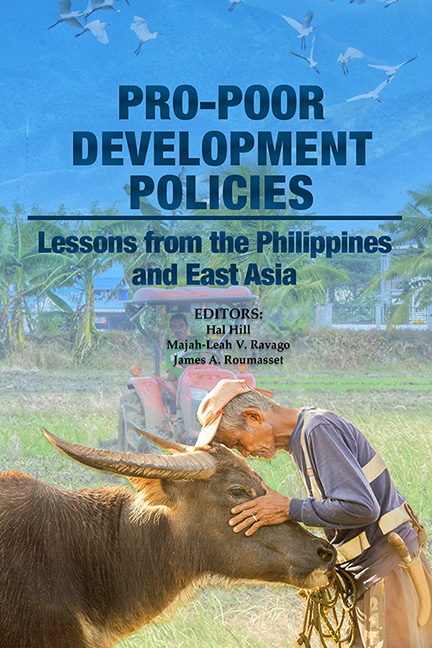Book contents
- Frontmatter
- Dedication
- Contents
- Figures, Tables and Boxes
- Foreword
- Foreword
- Message
- Preface and Acknowledgements
- About the Editors
- About the Contributors
- Acronyms
- Part 1 Introduction and Synthesis
- Part 2 Agricultural and Economic Development
- Part 3 Economic Policies for Achieving Targeted Levels of Living in the Philippines
- Part 4 Inequality and Economic Development
- Part 5 Competition Law and Policy
- Part 6 International Dimensions
- Index
16 - Social Differentiation: The Middle Class and Its Discontents
Published online by Cambridge University Press: 09 January 2024
- Frontmatter
- Dedication
- Contents
- Figures, Tables and Boxes
- Foreword
- Foreword
- Message
- Preface and Acknowledgements
- About the Editors
- About the Contributors
- Acronyms
- Part 1 Introduction and Synthesis
- Part 2 Agricultural and Economic Development
- Part 3 Economic Policies for Achieving Targeted Levels of Living in the Philippines
- Part 4 Inequality and Economic Development
- Part 5 Competition Law and Policy
- Part 6 International Dimensions
- Index
Summary
INTRODUCTION
Like all other countries, the Philippines has been severely affected by the COVID-19 pandemic that has engulfed the world since early 2020. As of this writing, growth performance for 2020 had been the worst since the country’s debt crisis in the 1980s (NEDA 2020; World Bank 2020). Most analysts expect the country to recover fully in late 2022 at the earliest. Conservative estimates place the number of Filipinos put out of work at one million due to government-mandated lockdowns; early in the lockdown, approximately more than 11 million out of the 18 million casual and temporary workers on the main island of Luzon have been affected by the crisis (Muyrong 2020). Close to four million of these workers were employed in the micro- and small-enterprise sector, as well as the retail and transportation sectors, which have been significantly affected by the crisis. Of these two sectors, only the food retail business was allowed to operate during the Luzon shutdown from April to May 2020 (Macaraeg 2020). There can be no doubt of the pandemic’s severe and lasting toll on the country’s efforts to reduce poverty and increase human development opportunities.
This turn of events becomes even more striking since the Philippines has performed well over the past decade relative to its historical record of growth and poverty reduction. Growth accelerated significantly and steadily since the mid-2000s; employment growth improved, decreasing the share of individuals and families below the poverty line. The country’s economic performance since 2012 has been regarded as among the best in the region (World Bank 2018a), amid cautious hopes that the country had finally shed its traditional label of being “an East Asian exception” (Clarete, Esguerra, and Hill 2018).
Among the immediate effects of these changes in welfare over the past years has been an increasing differentiation among Filipino households. The proportion of households belonging to categories between the richest and lowest income classes has increased—there has been an expansion in what may be called the “middle classes” of society. This is visible in the explosion in the number of retail-trade establishments, including large shopping malls; the expansion of demand for residential developments; and the rise in spending on consumer durables, including mobile devices, motor vehicles and household appliances.
- Type
- Chapter
- Information
- Pro-poor Development PoliciesLessons from the Philippines and East Asia, pp. 414 - 459Publisher: ISEAS–Yusof Ishak InstitutePrint publication year: 2022

